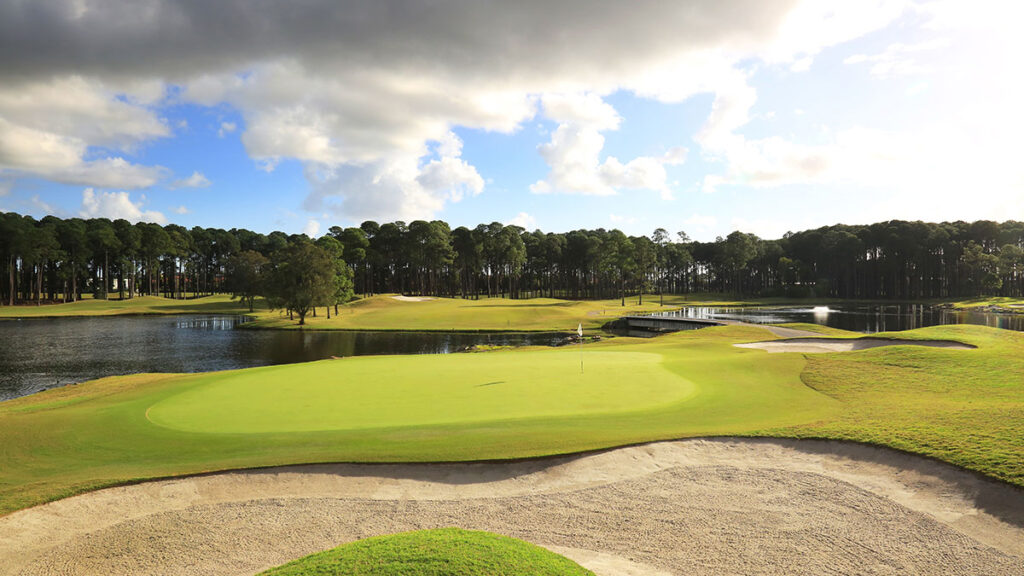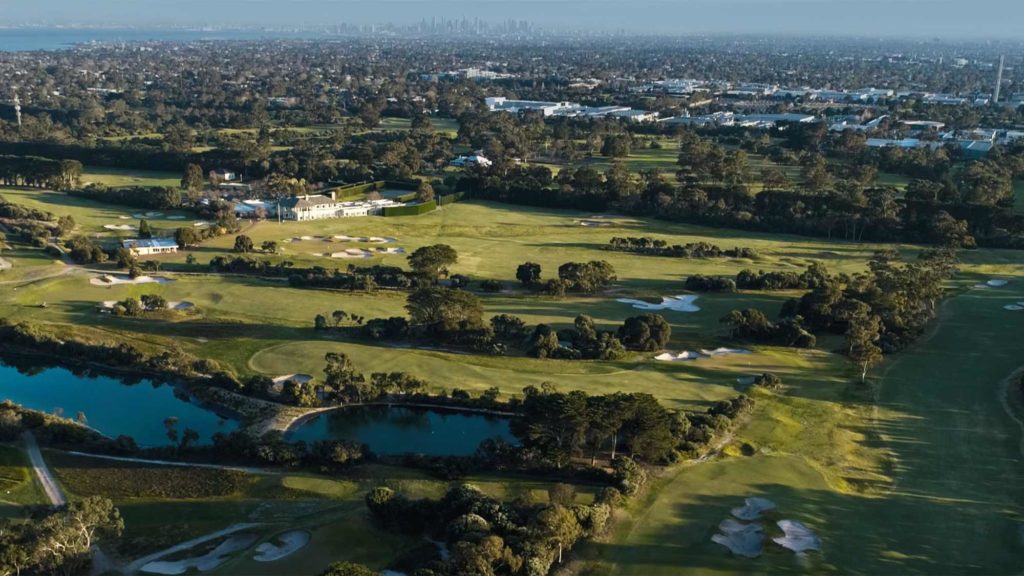The best greens in the country – and the genius behind their design – as judged by Australia’s top golf-course architects.
We admire their form, find sanctuary upon their pristine exterior, are confounded by their hidden subtleties and lament that we don’t hit more of them or putt on them fewer times. Greens on golf courses are as varied as the golf swings that strike the ball aboard them. Yet even though this collective non-uniformity is perhaps their most appealing characteristic, no part of a golf course receives more scrutiny. Conversely, many golfers will argue that good greens make up for almost any architectural shortcomings elsewhere on a layout.
Such a notion is usually centred on condition. It’s a peculiarity of modern golf that too many golfers equate ‘good’ with ‘smooth’ when in reality it’s the design of the greens that deserve greater commendation. Smooth and true are of course welcome traits, but cleverly designed greens in poor shape are still superior to unimaginative contours in peak condition. So tune your thoughts away from judging merely the agronomic quality of a putting surface and instead let the shapes mesmerise you.
Greens should be the opposite of human abdomens: flatter and smaller are not better. Large and voluptuous surfaces quiz the grey matter far more and add infinitely more character to a golf hole and golf course than small, flat, circular targets. They also add variety.
“I like big greens where the position of the pin changes the shots you hit to the green,” says Mike Clayton, who has forged a sparkling second career as a course architect after a successful one as a tour pro. “Smaller greens – and there is definitely a place for them – many times mean no matter where the flag is, you are still going to hit the same shot.”

A COMPLEX ISSUE
Course architecture is not a discipline that’s always easy to interpret. By its very nature, there are intangibles throughout and, like a few other areas of golf, there is a distinct marriage of art and science at play.
“Explaining how to design a green complex is much like an artist trying to explain how to paint a portrait,” John LaFoy, a past president of the American Society of Golf Course Architects, wrote on the society’s website. “Technically, it may be easy, but doing it is another story.”
LaFoy hits on a key term in course architecture: the “green complex”. It’s an important distinction from looking at the putting surface alone. Most course architects would argue the two are intertwined and that the surrounds of a green influence its shaping and design. However, in canvassing the opinions of a handful of Australian golf-course architects, we asked them to focus on just the greens themselves when deciding on the best sets across the country. That’s not an easy separation to make. Continuing LaFoy’s portrait analogy, the swales, bunkers and other hazards encircling a green might be viewed as being akin to hanging the right frame around a masterpiece.
“You don’t look at a portrait by taking out the surrounds of the subject. It’s not the same,” says Harley Kruse, also linking golf-course design to art. The Sydney-based architect and past president of the Australian Society of Golf Course Architects says he and his peers – as well as students of course architecture – need to view the entire green complex when making an assessment. “For good greens, the shapes flow out into the surrounds and vice versa,” Kruse adds. “The actual putting surface is just the part of the overall shape where grass is mown at less than three millimetres.”
Mike Cocking and Ashley Mead – the ‘C’ and ‘M’ in OCM Golf – concur.
“We tend to think it’s difficult to separate the putting surface from the green complexes. In our minds they’re all very much connected,” Cocking says. “Sometimes we rely on the green to add interest or strategy and other times it’s what’s going on around the green that’s important. For instance, a green might be quite plain in isolation and therefore not memorable, but then the bunkering or contouring around it creates the drama and strategy, elevating the hole to another level. The greens themselves are basically flat but the bunkering and hollows surrounding them help make the holes. So are the greens great or the green complexes?”
It’s an excellent point. Yet, in our Putting Issue, we’re eyeing the greens themselves (even though we – and you – tend to putt from off the green more and more). As such, in evaluating the premier putting surfaces in the land, we are analysing the shortest grass only.
Clayton insists there are three primary characteristics for good green design. Firstly, the best greens make for interesting putting. They should also set up the ideal line to play from and put an emphasis on where the tee shot – and second shot on par 5s – is played from. Less ‘sexy’ but equally important is how well-built they are and how they work with the ground around them.

“Unsurprisingly, the best greens are found on the best courses,” Clayton says.
Phil Ryan from Pacific Coast Design, the firm best known for penning Melbourne’s Gardiners Run course and the acclaimed Black Mountain layout in Thailand, says great greens depend on several fundamentals.
“While we can discuss ‘greens’ versus ‘green complexes’, it is difficult to ignore factors that do enhance quality greens,” he says. “For instance, golf architects have to think carefully about the extent and severity of contouring for a green, as while it may look great on the design desk it could be a disaster in the field. One new Australian golf course in links country had to have six of its greens redone as 90 percent of golf balls hit into the greens were not staying on the green surface but rolling off due to the slopes and often harsh environment (wind and dryness). A green in an exposed position, open to the elements, will react differently to the exact same designed green in a sheltered environment.
“Grass types used for greens also impact the potential contouring, speed and playability of the green as often seen in different parts of Australia (warm-season zones versus cool-season zones). There is also the tournament preparation of greens where the maintenance program and height of cut definitely affects the playability of the green. An Australian Open comes to mind where the tournament had to be halted due to the unplayability of greens that a few weeks earlier members had little issue with,” Ryan says.
In his online essay, LaFoy illustrates the instinct required to design the best greens. While an intricate and detailed process in so many ways, a good course architect’s artistic side and innate ability to ‘see’ what’s best will always shine through.
“A USGA green section representative once asked an architect how he knew when to elevate a green,” LaFoy wrote. “The architect responded, ‘I don’t know; I just do.’ That was as good an answer as any. He might have just said ‘experience’, although all the experience in the world may not translate in the ability to design greens.”
Naturally, different course architects see, read and react to green sites in differing ways. Some like bold undulations regardless of a site’s natural movement and features, others prefer the putting surfaces to be more subtle in contour. Many designers keep it versatile and vary their approach to greens based on the site (or in some instances, the brief). Everyday golfers can learn a lot from just a little observation of the greens they play on. Voluptuous shapes – such as at the Old course at The National – aren’t difficult to pick. In fact it’s impossible to miss the huge tiers, waves and ripples across Robert Trent Jones Jnr’s gem on Victoria’s Mornington Peninsula, but understanding the nuances hidden within such bold movements takes a keener eye. Elsewhere, however, you might encounter contours that don’t reveal their full shape until you’re trying to putt from one section of a green to another, or see a ball slide quietly off the surface thanks to a delicate decline near its edge.
Slope versus tilt is another aspect to consider. The slope of a green means the various contours within the putting surface, with several different slopes often found on the same green. Tilt refers to the overall prevailing slant of a green. Many of Royal Melbourne’s greens are tremendous examples of tilt and the need to be putting from the correct part of a green to each pin position. Most surfaces on the Melbourne Sandbelt are structured the same way, as nuance within these greens reigns in contrast to the prominent bunkering. It truly is a magnificent concert of subtlety sitting alongside striking across the revered sand strip.

Tilt and angle are terms that can be confused, although both can work in harmony. Angle usually refers to how a green might be oriented to offer an easier approach from a certain section of the fairway (generally the riskier part to drive to). Equally, the tilt of a green can play the same role, like on the Melbourne Sandbelt. When it comes to angle, Bill Coore’s genius par-4 14th hole at Barnbougle Lost Farm offers a classic illustration. The green is angled to favour the bold drive into the hard-to-reach pocket of fairway short and right of the surface, while the timid tee shot leaves a far more awkward pitch across the now less-receptive contours of the target. The fourth hole at Stonecutters Ridge in western Sydney works similarly, but in a more subtle fashion. A vast, conjoined fairway with the third hole beckons to the left, giving golfers an immense stretch of safe ground to play towards to avoid the water lining the right side. However, the further left the tee shot ventures, the more difficult the second becomes due to the angle of the narrow target, which is more welcoming of shots hit from the more dangerous right side. It’s a time-honoured design tool, utilised in this instance by Greg Norman and Bob Harrison.
Green size is another factor, as Clayton alluded to above. Small greens are less likely to have wild undulations, if for no other reason than such shaping reduces the proportion of ‘pin-able’ areas within the green. It makes little sense to adopt a small-green design approach then limit the number of hole-location options due to excessive contouring. But good, small greens still have their place even if it’s not a common architectural trend today.
“Woodlands makes my list because it’s the best set of ‘small’ greens in the country,” Clayton says of his list of the top 10 sets of greens in Australia.
Rowley Banks and Sam Bennett’s greens at Woodlands are revered for their lack of size rather than in spite of it. Its smaller targets amplify the need for sharp iron play and reward good approaches with shorter putts. Clayton, Ryan and Cocking each rate the Woodlands greens in their personal top 10s in Australia.
Big versus small, subtle versus overt, wild versus gentle. The best aspect of the greens at Australia’s top golf courses is that such variety genuinely does add spice.





